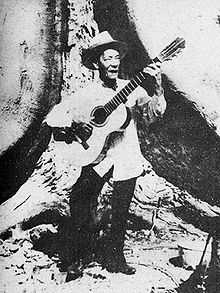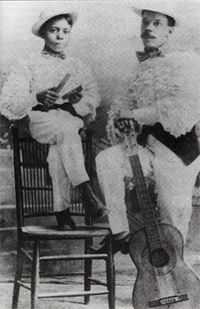Sindo Garay

in front of huge tree
Sindo Garay was born Antonio Gumersindo Garay Garcia (Santiago de Cuba, 12 April 1867 – Havana, 17 July 1968). He was the first, the smallest,[1] and perhaps the longest-lived,[2] of the trova artists taught by Pepe Sánchez. Garay was one of the four greats of the trova. Sindo Garay was Spanish & Arawkan descendant. He was Indo-Cuban.
Life & work
Garay was the most outstanding composer of trova songs, and his best have been sung and recorded many times. Perla marina, Adios a La Habana, Mujer bayamesa, El huracan y la palma, Guarina and many others are now part of Cuba's heritage. Garay was also musically illiterate – in fact, he only taught himself the alphabet at 16 – but in his case not only were scores transcribed by others, but there are recordings as well.

For a long period he sang in a duo with his eldest son Guarionex; he had two other sons and a daughter, and gave them all Indian names.
In the 1890s Garay got involved in the Cuban War of Independence, and decided a stay in Hispaniola (Haiti and Dominican Republic) would be a good idea. It was, and he came back with a wife. Garay settled in Havana in 1906, and in 1926 joined Rita Montaner and others to visit Paris, spending three months there singing his songs. He broadcast on radio, made recordings and survived into modern times. He used to say "Not many men have shaken hands with both Jose Marti and Fidel Castro!" Carlos Puebla, whose life spanned the old and the new trova, told a good joke about him: "Sindo celebrated his 100th birthday several times – in fact, whenever he was short of money!" [3][4]
References
- ↑ photographs of him close to others show him to be 5’ at most
- ↑ Chicho Ibáñez lived longer, though he was probably not taught by Sánchez
- ↑ Sublette, Ned 2004. Cuba and its music: from the first drums to the mambo. Chicago. p298
- ↑ de Leon, Carmela 1990. Sindo Garay: memorias de un trovador. La Habana. Garay's life story as told in his nineties; includes a 16-page appendix listing his compositions.
|